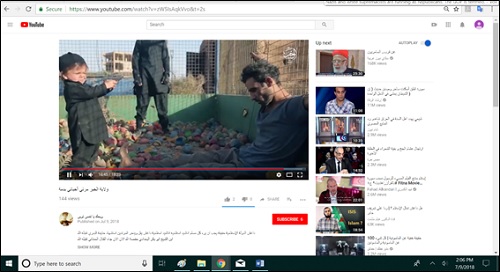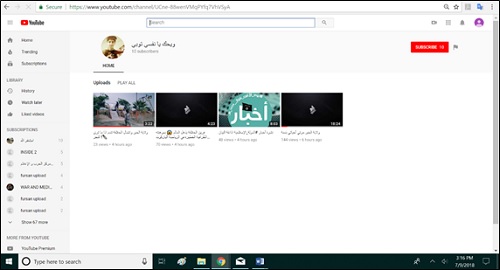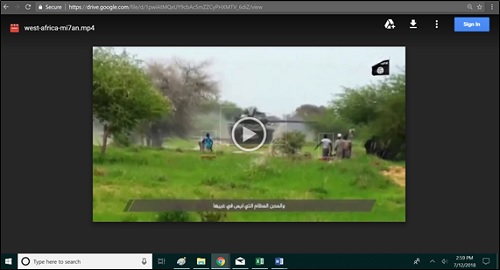Success On Battlefield Against Terrorist Group Offset By Adept Use Of Online Messaging Platforms
Following the latest media trend, ISIS now has a fake news problem. This week, the Independent reported that the terrorist organization was subject to an “onslaught of spoof propaganda and cyberattacks by international intelligence agencies.” The more striking details, however, were how the terrorist organization responded. In a message sent to its followers, ISIS reiterated that all official communiques – including text, video and photo reports – were to only come from Telegram. But that doesn’t stop its content from being seen by thousands and spread by supporters “on mainstream websites and social media platforms ... around the world.”
One ISIS affiliate in West Africa this week released a video on Telegram from the Niger-Nigeria-Chad border titled “Tribulations and Blessings.” This is the first video release from ISIS’s self-proclaimed province in West Africa in almost a year, and has similar structure and content to videos released from Iraq and Syria. Additionally, the video shows the use of an improvised explosive device and armored suicide vehicle in that region for the first time. The Economist featured a story in their July 14 issue about the rise of ISIS in the Niger-Nigeria border region, which has already cost more than 10,000 lives. The video was originally released on at least 21 websites in addition to Telegram, including Google Drive, Vimeo and Dailymotion.
Despite recent successes against ISIS on the battlefield, the threat of terrorism has proved to be more resilient than ever. According to The New York Times, that can be attributed to their adept use of “the tools of globalization – including Bitcoin and encrypted communications.” Social media platforms, such as Telegram, have made conducting terrorist attacks easier than ever. Tactics learned by extremists overseas can be swiftly learned by those here at home “for aspiring terrorists and even lone actors in their own lethal plans.”
To view examples of extremist content found online, please see the background below. To view additional examples, please contact CEP at [email protected].
EXTREMIST CONTENT ONLINE
ISIS Video Featuring Young Child Committing Executions Live On YouTube For Over Six Hours
On Monday, July 9, “He Revived Me By His Blood” was reuploaded to YouTube, and remained on the site for more than six hours. The video, originally released in January 2017, features three executions committed by children, including an execution by shooting committed by a very young child (approximately four years old). The video had 144 views and was on YouTube for more than six hours before it was removed.


The account that uploaded the video. The specific video in question is on the far right with 144 views and was on the site for over six hours before it was removed.
New Video From ISIS’s West African Affiliate
On July 11, ISIS’s affiliate in West Africa released a video from the Niger-Nigeria-Chad border titled, “Tribulations and Blessings.” This is the first video release from ISIS’s self-proclaimed province in West Africa in almost one year. The video has similar structure and content to videos released from Iraq and Syria. Additionally, the video shows the use of an improvised explosive device and armored suicide vehicle in that region for the first time. The Economist featured a story in their July 14 issue about the rise of ISIS in the Niger-Nigeria border region.
The video was originally released on at least 21 websites in addition to Telegram: Mediafire, pc.cd, SendVid, Microsoft One Drive, top4top.net, the Internet Archive, mail.ru, Dailymotion, Google Drive, Dropbox, file.fm, Gulfupload, mega.nz, ok.ru, Google Photos, tune.pk, upmlf, Vimeo, Amazon Cloud Drive, yadi.sk and YouTube. Approximately 10 hours later, the video was still available on 12 websites: Mediafire, Microsoft One Drive, Top4Top.net, the Internet Archive, Google Drive, Google Photos, Dropbox, Gulfupload, ok.ru, upmlf, Amazon Cloud Drive and yadi.sk.

“Tribulations and Blessings” on Google Drive on July 12, approximately 10 hours after the video was uploaded.
BACKGROUND
Counterterrorism Agencies Have Been Using Social Media To “Spoof” ISIS. “Isis has ordered supporters to follow only its ‘official’ channels amid an onslaught of spoof propaganda and cyberattacks by international intelligence agencies. A panicked message issued by the terrorist group’s Nashir News Agency on encrypted messaging app Telegram warned against the spread of fake Isis-related news. ‘There are currently no Nashir News Agency accounts on Twitter, Instagram, WhatsApp or any site other than Telegram, nor is there any account providing links other than known agency accounts,’ it said … Europol said Isis’s ability to broadcast and publicise terrorist material had been ‘compromised’ by a mix of cooperation with internet service providers and cyberattacks.” (Lizzie Dearden, “Isis Orders Supporters To Use Official Channels After Onslaught Of Fake Propaganda And Cyberattacks,” Independent, 7/11/18)
Although ISIS Reiterated That Official Communications Were Only To Come From Telegram, Nothing Stops Its Followers From Spreading The Messages Across The Internet. “The channel issues text, video and photo reports from militants in Iraq, Syria, Afghanistan, Egypt and other countries, as well as material aiming to inspire and instruct followers to launch global terror attacks. Each Telegram post is seen several thousand times on average, before being translated and spread further on mainstream websites and social media platforms by supporters around the world … The group has prioritised the creation of a ‘virtual caliphate’ intended to survive its huge territorial losses in Iraq and Syria, and its slick propaganda operation has been credited with attracting an unprecedented number of foreign supporters.” (Lizzie Dearden, “Isis Orders Supporters To Use Official Channels After Onslaught Of Fake Propaganda And Cyberattacks,” Independent, 7/11/18)
ISIS Has Proven To Be Resilient, Despite Gains On The Battlefield. “In Germany and France, the authorities thwarted terrorists’ plots to attack with the deadly poison ricin. In eastern Syria, the Islamic State continued its retreat under stepped-up assaults by Kurdish militia and Iraqi pilots. And extremists in Yemen, Somalia and Libya were targeted by American airstrikes. That spate of action, over the past few weeks alone, illustrates the shifting and enduring threat from Islamic extremism around the world that will last long after the Islamic State, also known as ISIS, is defeated on the battlefield.” (Eric Schmitt, “ISIS May Be Waning, But Global Threats Of Terrorism Continue To Spread,” The New York Times, 7/6/18)
That Is, In Part, Due To Its Ability To Leverage Social Media And The Internet. “The Islamic State, in particular, is adapting to setbacks and increasingly using the tools of globalization – including Bitcoin and encrypted communications – to take their fight underground and rally adherents around the world … Even away from the battlefield, extremists on social media and the internet are proving to be potent. French authorities foiled a ricin plot by an Egyptian-born student in May after intercepting messages on the secure social media platform Telegram … Now, officials worry that the know-how from these specialized battlefield plots and operations is seeping into everyday social media conduits, where they are available for aspiring terrorists and even lone actors in their own lethal plans.” (Eric Schmitt, “ISIS May Be Waning, But Global Threats Of Terrorism Continue To Spread,” The New York Times, (7/6/18)